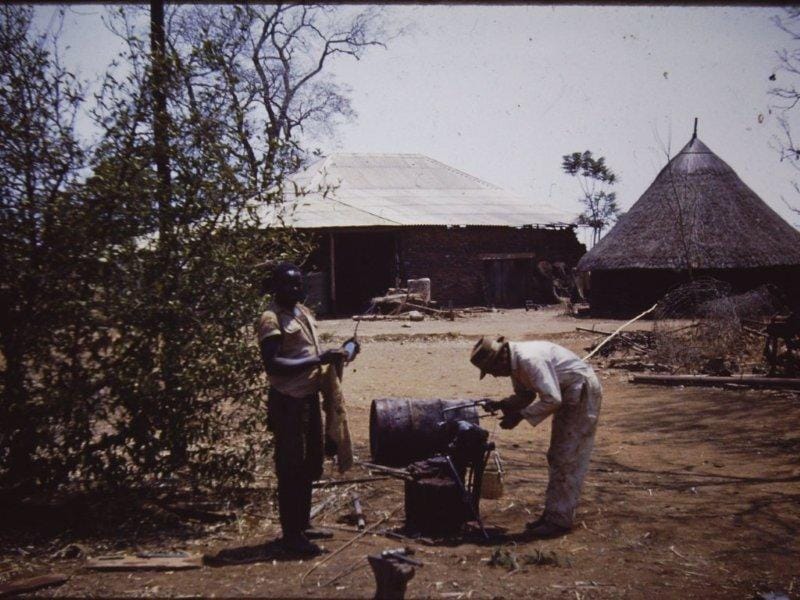Team Power

In 1942 Gervas Hughes converted the cow shed on his farm into a saw mill and blacksmith shop to manufacture his own equipment to make every part of his Scotch carts.
Team Power
Gervas Hughes sold the Greenham dairy herd and milk run concentrating on his transport business after his beautiful wife Barbara died. He converted the large concrete floored cow shed to a saw mill and made scotch carts–two wheeled wagons pulled by two oxen. He and his men made every part of the carts, even the manufacturing equipment.
The men cut and carted timber from local forests and built an oversized lathe to turn wagon hubs. The lathe was also used to turn four foot long windlasses, sold to small workers, to be used on mine shafts and water wells. The winding handles were made in Gervas’ farm blacksmith shop. Tim would spend much of his holidays watching and learning. A special treat for the children was to ride in the traction engine when Gervas was working at the Umniati River drift. Tim would remember it all his life.
Team Power
The Umniati River drift was about two hundred meters wide and had a gradual sandy descent to a reasonably flat rocky crossing. In the dry season the water level was less than a meter but impassable in the wet. Wagons loaded with firewood for the gold mines were drawn into the drift by spans of bullocks to form a line of three coupled together.
The spans then free of their loads were led across the Umniati up onto level ground to await their wagons. A long mine winch cable, pulled across the river by oxen, was coupled to the front of the three. The other end of the cable was hitched to the steam powered traction engine. The engine driver, traveling on flat land away from the river, could not see the wagons. He relied on a flagman on the river bank who could monitor their progress. If the flag was waved to and fro, the traction engine slowly pulled the wagons through the drift, if it was held stationary the driver stopped; up and down signaled reverse.
The operation often continued into the night when burning logs had to be used instead of flags to make the signals. Sometimes a wheel would fall into a hole and the wagon would turn over spilling firewood into the river. The engine would be signaled to a sudden halt. A span of oxen would be despatched to right the wagon and a team of men to reload the firewood.
The traction engine, as powerful as a steam locomotive was driven by an African named Samson. He was very kind to Angela and Tim, allowing them to ride in the cab with him and his assistant, who stoked the boiler with short lengths of firewood. Samson could not be distracted from keeping a watchful eye on the flagman.
Decades later the traction engine was sold to a brick maker to power his machinery. When the business failed, the engine was left idle and robbed of all its brass fittings by African scrap metal thieves. A beautiful machine damaged beyond repair for the sake of a few dollars worth of scrap brass!
Many Thanks to Tim Hughes of Queensland, Australia for the picture and the excerpts from his unpublished manuscript Matambega and Son written in the 1980’s.
